We Mailed the Kids Oversized Again
Americans Used To Send Their Babies via the U.Due south. Postal service
Sending via mail was cheaper than a railroad train ticket

 O nce upon a fourth dimension, in the United states, information technology was legal to send babies and children through the U.Southward. Postal Service. Sending big parcels was considered a significant innovation at the beginning of the 20th century.
O nce upon a fourth dimension, in the United states, information technology was legal to send babies and children through the U.Southward. Postal Service. Sending big parcels was considered a significant innovation at the beginning of the 20th century.
The delivery organization was a bang-up convenience for the Americans, peculiarly those living in rural areas. The new service thrilled the population to the point that they had started to send annihilation they could through the packet post, fifty-fifty their babies and children.
No stringent guidelines on packages
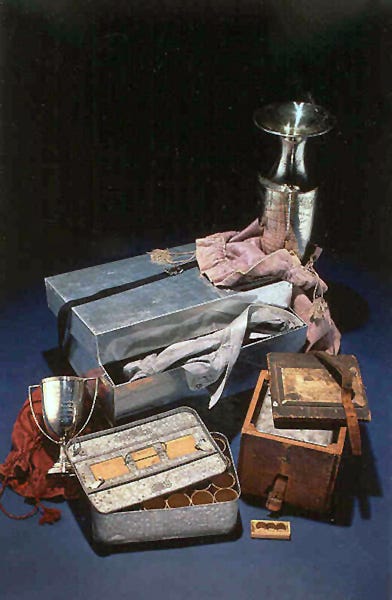
On Jan i, 1913, the U.Southward. Postal service announced its latest expansion of delivering big parcels or packages nationwide. At starting time, subcontract families were anxious to accept the new service. Earlier 1913, farmers had to bring their appurtenances to the nearest town that was big plenty to back up an express role, which added to the city's cost for transporting their products.
Still, because of the convenience of delivering their goods right from their door — the new postal's organisation became a miracle, as Americans had better access to a wide variety of goods and services. The packet service became essential in the United States. During its kickoff six months of operations, there were about 300 meg parcels already delivered around the country. Since then, the post's officials increased the commanded weight of packages from eleven to twenty pounds. Somewhen, the maximum weight rose once again from 20 to fifty pounds.
The kickoff package the U.S. Postal service delivered was a box of six eggs mailed from St. Louis to Edwardsville, Illinois. When it was sent back to St. Louis, information technology was already a freshly baked cake. According to Smithsonian's National Museum curator Nancy Pope, the U.S. Postal Service then failed to specify what could and non could be mailed via the new packet delivery service. Therefore, Americans tested the limit of sending parcels.
Baby Mail service: very special parcels
In mid-Jan 1913, Jesse and Mathilda Beagle "mailed" their eight-month-one-time son James to his grandmother in Batavia, Ohio. Baby James was nearly xi-pounds, which was however nether the weight limit for packages sent via bundle post.
"The boy's parents paid 15-cents for the stamps and even insured their son for $fifty." — Nancy Pope
The postman, named Vernon O. Lytle, delivered James to his grandmother, Mrs. Louis Beagle. The Beagles' story landed in the newspapers, which encouraged other parents to follow suit. At least five more children were officially mailed and delivered between 1914 and 1915.
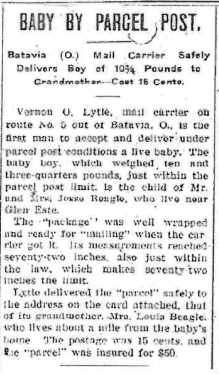
Mail-club-baby enquiry
On Jan 16, 1913, Postmaster-General Hitchcock received a letter addressed to him, its sender was asking how to wrap a baby in a suitable way.
Ft. McPherson, Ga.
Postmaster General :
Washington, D.C."Sir: I take been corresponding with a party in Pa. about getting a babe to rais[e] (Our home being without I). May I ask you what specifications to utilize in wrapping, and then it [Baby] would comply with regulations and exist immune shipment by packet post equally the limited Co. are too crude in handling. Yours — "
Hitchcock, being a bachelor, had seriously no idea how to respond to such an inquiry. All the same, he considered consulting experts regarding babies' transportation.
From mailing babies to mailing children
A story in the New York Times published a similar report wherein a grandmother in Stratford, Oklahoma, sent a two-year-former kid to his aunt in Wellington, Kansas:
"The boy wore a tag almost his neck showing information technology had cost eighteen cents to send him through the mails. He was transported 25 miles by rural road before reaching the railroad. He rode with the postal service clerks, shared his lunch with them and arrived here in adept condition." — New York Times
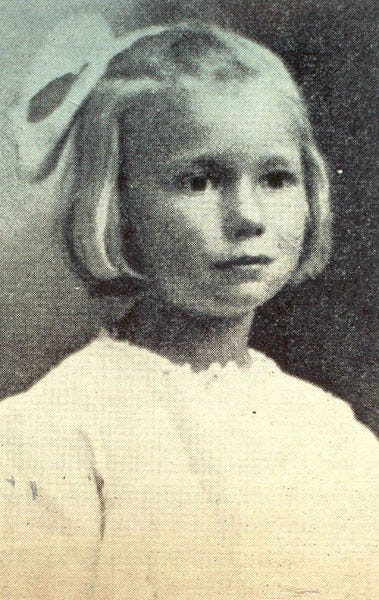
Withal, co-ordinate to the Smithsonian Mag, the near famous story of child-post was Charlotte May Pierstorff, a four-year-former child, weighing forty-8 point five pounds. Her parents realized that sending her past mail would exist cheaper than ownership her a train ticket. They purchased a fifty-iii cents bundle post postage stamp and attached it to May's coat.
May rode in the train'due south mail compartment all the way to Lewiston, Idaho. She was delivered to her grandmother's home by Leonard Mochel, the mail clerk on duty. However, according to some reports, May'southward cousin too worked in the post, that'south why she got on lath. When Postmaster-Full general Albert Burleson heard about this incident, he banned postal workers accepting humans as mail.
Nevertheless, the new regulation didn't immediately stop people from sending their children by post. A year later, a adult female mailed her six-year-old daughter from her home in Florida to her father'due south business firm in Virginia. At 720 miles, information technology was the most extended postal trip of children that has ever been identified, which price fifteen-cents in stamps.
Special treatment of babies and children
"A mailman might have carried a swaddled child who couldn't walk, but he wouldn't have let a diaper-wearing baby sit in a pile of people'due south mail." — Jenny Lynch
According to the United states of america Postal Service historian Jenny Lynch, babies and children delivered via postal service were non sacked into boxes or wrapped like gifts, they were handled with care. A manifestation of Lynch'south statement was the story of Maud Smith, a iii-year-old who was mailed by her grandmother twoscore-miles through Kentucky to visit her sick mother on August 31, 1915.
Maud was put on an O & 1000 railroad train at Caney, Morgan Canton, and arrived at Jackson at 11:00 a.thousand. The post clerk pinned a alphabetic character on her wearing apparel and stated that he doubted the mailing's legality. However, he said, "the kid was on the mail train; therefore, she must exist delivered." On the mode to her mother'south house, Maud was seen sitting on a pile of mail sacks in the postman'due south railroad vehicle.
"A great crowd follow the mail wagon from the L & Eastward depot every bit mail carrier James Haddix carried a package post babe to the Jackson mail service-office. The child was seated on the a pack total of postal service sacks between the mail carrier's knees and was busily eating away at some processed [she] carried in a bag. In the other hand [she] carried a big reddish apple tree and [she] smiled when the curious folks waved their hands and called to her."
"The child was wearing a pink dress to which was sewed a shipping tag, covered on one side with 30-iii cents in stamps and on the other side had the following words: To Mrs. Celina Smith, care Jim Haddix, Jackson Ky., from R.K. Maden, Caney, Ky."
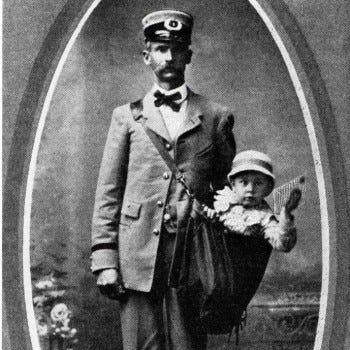
Permanent halt for sending babies and children
Some accounts said that Maud Smith appears to be the concluding child to be sent via mail. Notwithstanding, Lynch said that it was unlikely, as some reports stated that the mailing of babies and children continued until the 1920s.
Also, based on the news of the Los Angeles Times on June 14, 1920, Outset Assistant Postmaster-Full general Koons finally ruled that the activity was unacceptable every bit babies and children "did not come within the classification of harmless live animals." Since then, babies and children have had to ride the railroad train, jitney, and plane like everyone else and not with cargoes, letters, bugs, and animals.
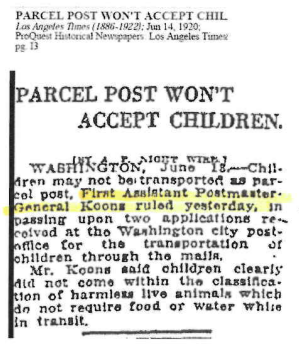
Epilogue
While the odd do of mailing out children might be seen as incompetence or negligence on the part of the postal service carriers, Lynch argued that it was more an example of how much rural communities relied on and trusted local postal workers. Mail service carriers were trusted public servants, and even infants' and children's lives were entrusted upon their hands to ensure they safely arrived at their destination.
In these mod times, despite all the available technologies, the U.S. Mail however plays a vital role in society. Apart from the fact that they are responsible for sending letters and packages, they are also accountable for handling the extremely of import post-in-votes for the U.Due south. Presidential election.

Source: https://historyofyesterday.com/americans-used-to-send-their-babies-via-the-u-s-postal-service-136de30316bb
0 Response to "We Mailed the Kids Oversized Again"
Post a Comment